Comparison of the Economic Performances of Three Sulphur Oxides Emissions Abatement Solutions for a Very Large Crude Carrier (VLCC)
Abstract
:1. Introduction
1.1. International Regulatory Framework and Technologically Feasible Solutions
- A: Using LNG as a marine fuel with dual-fuel engines.
- B: Installing scrubber with using HFO.
- C: Using LSFO.
1.2. Literature Review
1.3. Reseach Questions
2. Materials and Methods
2.1. Parameters of The VLCC
2.2. Methodology
2.2.1. Step 1: Prediction of Fuel Prices (LNG, HFO and LSFO)
2.2.2. Step 2: Evaluation of the Annualized Additional CAPEX
2.2.3. Step 3: Evaluation of Parameter
2.2.4. Step 4: Evaluation of Parameter
2.2.5. Step 5: Calculation of
3. Results
3.1. Calculation of Fuel Comsumptions for Three Solutions
3.2. Results Based on Initial Target Payback Period
3.3. Results Based on Variuos Target Payback Periods
4. Discussion
5. Conclusions
- the indicator for the economic comparison;
- the CAPEX and OPEX of each solution;
- the most optimal SOx abatement solution for the target VLCC.
Author Contributions
Funding
Institutional Review Board Statement
Informed Consent Statement
Conflicts of Interest
Abbreviations
| BTU | British Thermal Unit |
| CAPEX | Capital expenditures |
| CARB | California’s air resources board |
| CO2 | Carbon dioxide |
| DECAs | Domestic emission control areas |
| DWT | Deadweight tonnage |
| EC | European Commission |
| ECAs | Emission control areas |
| EEDI | Energy efficiency design index |
| EGCS | Exhaust gas cleaning system |
| EP | Economic performance |
| EU | European Union |
| EUR | Euro (European monetary unit) |
| FGSS | Fuel gas supply system |
| GHG | Greenhouse gas |
| HFO | Heavy fuel oil |
| IFO | Intermediate fuel oil |
| IMO | The International Maritime Organization |
| IMO IGF Code | The International Code of Safety for Ships using Gases or other Low-flashpoint Fuels |
| IRR | Internal rate of return |
| LNG | Liquified natural gas |
| LSFO | Low-sulphur fuel oil |
| MARPOL | The International Convention for the Prevention of Pollution from Ships |
| MCR | Maximum continuous rating |
| MEPC | Marine environment protection committee |
| MGO | Marine gas oil |
| NOx | Nitrogen oxide |
| NPV | Net present value |
| OPEX | Operating expense |
| PM | Particulate matter |
| RQ | Research question |
| SCR | Selective catalytic reduction |
| SECAs | Sulphur emission control areas |
| SOx | Sulphur oxides |
| TEU | Twenty-foot equivalent unit |
| US | United States |
| USD | United States dollar |
| VEM | Voyage expenses-based method |
| VLCC | Very large crude carrier |
| Symbols | |
| Additional capital expenditures (CAPEX) per voyage within the target payback years | |
| Conversion factor between fuel consumption and CO2 emission | |
| Cost of installation and commissioning of scrubber | |
| Cost of scrubber | |
| Indicator of the economic performance | |
| Consumption of HFO | |
| Initial investment | |
| Consumption of LNG | |
| Consumption of LSFO | |
| Targeted payback years | |
| Operating expense (OPEX) | |
| 75% of rated installed power (MCR) for each main engine | |
| Price of MGO | |
| Price of HGO | |
| Price of LSFO | |
| Discount rate | |
| Specific fuel consumption |
References
- Dore, A.J.; Vieno, M.; Tang, Y.S.; Dragosits, U.; Dosio, A.; Weston, K.J.; Sutton, M.A. Modelling the atmospheric transport and deposition of sulphur and nitrogen over the United Kingdom and assessment of the influence of SO2 emissions from international shipping. Atmos. Environ. 2007, 41, 2355–2367. [Google Scholar] [CrossRef] [Green Version]
- Smith, S.J.; Van Aardenne, J.; Klimont, Z.; Andres, R.J.; Volke, A.; Arias, S.D. Anthropogenic sulfur dioxide emissions: 1850–2005. Atmos. Chem. Phys. Discuss. 2011, 11, 1101–1116. [Google Scholar] [CrossRef] [Green Version]
- Eyring, V.; Köhler, H.W.; Van Aardenne, J.; Lauer, A. Emissions from international shipping: 1. The last 50 years. J. Geophys. Res. Space Phys. 2005, 110, 171–182. [Google Scholar] [CrossRef]
- Endresen, Ø.; Sørgård, E.; Sundet, J.K.; Dalsøren, S.B.; Isaksen, I.S.A.; Berglen, T.F.; Gravir, G. Emission from international sea transportation and environmental impact. J. Geophys. Res. Space Phys. 2003, 108. [Google Scholar] [CrossRef]
- Bouman, E.A.; Lindstad, E.; Rialland, A.I.; Strømman, A.H. State-of-the-art technologies, measures, and potential for reducing GHG emissions from shipping—A review. Transp. Res. Part D Transp. Environ. 2017, 52, 408–421. [Google Scholar] [CrossRef]
- IMO. Reduction of GHG Emissions from Ships—Third IMO GHG Study 2014—Final Report; International Maritime Organization: London, UK, 2015. [Google Scholar]
- Chen, D.; Zhao, Y.; Nelson, P.; Li, Y.; Wang, X.; Zhou, Y.; Lang, J.; Guo, X. Estimating ship emissions based on AIS data for port of Tianjin, China. Atmos. Environ. 2016, 145, 10–18. [Google Scholar] [CrossRef]
- Li, C.; Yuan, Z.; Ou, J.; Fan, X.; Ye, S.; Xiao, T.; Shi, Y.; Huang, Z.; Ng, S.K.; Zhong, Z.; et al. An AIS-based high-resolution ship emission inventory and its uncertainty in Pearl River Delta region, China. Sci. Total Environ. 2016, 573, 1–10. [Google Scholar] [CrossRef] [PubMed]
- Liu, T.K.; Chen, Y.S.; Chen, Y.T. Utilization of vessel automatic identification system (AIS) to estimate the emission of air pollutant from merchant vessels in the port of Kaohsiung. Aerosol Air Qual. Res. 2019, 19, 2341–2351. [Google Scholar] [CrossRef]
- Ekmekçioğlu, A.; Kuzu, S.L.; Ünlügençoğlu, K.; Çelebi, U.B. Assessment of shipping emission factors through monitoring and modelling studies. Sci. Total Environ. 2020, 743, 140742. [Google Scholar] [CrossRef] [PubMed]
- Zhang, Y.; Yang, X.; Brown, R.; Yang, L.; Morawska, L.; Ristovski, Z.; Fu, Q.; Huang, C. Shipping emissions and their impacts on air quality in China. Sci. Total Environ. 2017, 581-582, 186–198. [Google Scholar] [CrossRef] [PubMed]
- Mao, J.; Zhang, Y.; Yu, F.; Chen, J.; Sun, J.; Wang, S.; Zou, Z.; Zhou, J.; Yu, Q.; Ma, W.; et al. Simulating the impacts of ship emissions on coastal air quality: Importance of a high-resolution emission inventory relative to cruise- and land-based observations. Sci. Total Environ. 2020, 728, 138454. [Google Scholar] [CrossRef] [PubMed]
- Russo, M.; Leitão, J.; Gama, C.; Ferreira, J.; Monteiro, A. Shipping emissions over Europe: A state-of-the-art and comparative analysis. Atmos. Environ. 2018, 177, 187–194. [Google Scholar] [CrossRef]
- Miola, A.; Ciuffo, B.; Giovine, E.; Marra, M. Regulating Air Emissions from Ships: The State of the Art on Methodologies, Technologies and Policy Options; JRC: Luxembourg, 2010. [Google Scholar]
- IMO. Annex VI Prevention of Air Pollution from Ships of International Convention for the Prevention of Pollution from Ships (MARPOL); International Maritime Organization: London, UK, 2005. [Google Scholar]
- Lindstad, H.E.; Rehn, C.F.; Eskeland, G.S. Sulphur abatement globally in maritime shipping. Transp. Res. Part D Transp. Environ. 2017, 57, 303–313. [Google Scholar] [CrossRef] [Green Version]
- Jang, H.; Jeong, B.; Zhou, P.; Ha, S.; Nam, D.; Kim, J.; Lee, J.-U. Development of Parametric Trend Life Cycle Assessment for marine SOx reduction scrubber systems. J. Clean. Prod. 2020, 272, 122821. [Google Scholar] [CrossRef]
- European Union. Directive 2005/33/EC of the European parliament and of the council. Off. J. Eur. Union 2005, 191, 60–65. [Google Scholar]
- CARB. Marine Notice 2013-1 Advisory to Owners or Operators of Ocean-Going Vessels Visiting California Ports; California Air Resources Board: Sacramento, CA, USA, 2013. [Google Scholar]
- Ministry of Transport of the People’s Republic of China. Implementation Scheme of the Domestic Emission Control Areas for Atmospheric Pollution from Vessels; Ministry of Transport of the People’s Republic of China: Beijing, China, 2018.
- Kim, A.-R.; Seo, Y.-J. The reduction of SOx emissions in the shipping industry: The case of Korean companies. Mar. Policy 2019, 100, 98–106. [Google Scholar] [CrossRef]
- DNVGL. Global Sulphur Cap 2020: Get Insights on Compliance Options and Implications for Shipping. 2019. Available online: https://www.dnvgl.com/publications/global-sulphur-cap-2020-updated-in-2019--84567 (accessed on 1 December 2020).
- Clarksons. World Fleet Register; Clarksons Research: London, UK, 2020. [Google Scholar]
- Jiang, L.; Kronbak, J.; Christensen, L.P. The costs and benefits of sulphur reduction measures: Sulphur scrubbers versus marine gas oil. Transp. Res. Part D Transp. Environ. 2014, 28, 19–27. [Google Scholar] [CrossRef]
- Panasiuk, I.; Turkina, L. The evaluation of investments efficiency of SOx scrubber installation. Transp. Res. Part D Transp. Environ. 2015, 40, 87–96. [Google Scholar] [CrossRef]
- Adachi, M.; Kosaka, H.; Fukuda, T.; Ohashi, S.; Harumi, K. Economic analysis of trans-ocean LNG-fueled container ship. J. Mar. Sci. Technol. 2014, 19, 470–478. [Google Scholar] [CrossRef]
- Livanos, G.; Theotokatos, G.; Dimitrios‑Nikolaos, P. Techno-economical investigation of alternative propulsion concepts of ferries operating in mediterranean sea—Introduction of LNG as alternative fuel. In Proceedings of the 3rd International Conference on Contemporary Problems of Thermal Engineering, Gliwice, Poland, 18–20 February 2013. [Google Scholar]
- Tzannatos, E.; Papadimitriou, S.; Koliousis, I. A Techno-Economic Analysis of Oil vs. Natural Gas Operation for Greek Island Ferries. Int. J. Sustain. Transp. 2014, 9, 272–281. [Google Scholar] [CrossRef]
- Ge, J.; Wang, X. Techno-economic study of LNG diesel power (dual fuel) ship. WMU J. Marit. Aff. 2017, 16, 233–245. [Google Scholar] [CrossRef]
- Zhao, Y.; Fan, Y.; Fagerholt, K.; Zhou, J. Reducing sulfur and nitrogen emissions in shipping economically. Transp. Res. Part D Transp. Environ. 2021, 90, 102641. [Google Scholar] [CrossRef]
- Schinas, O.; Butler, M. Feasibility and commercial considerations of LNG-fueled ships. Ocean Eng. 2016, 122, 84–96. [Google Scholar] [CrossRef]
- Lee, H.-J.; Yoo, S.-H.; Huh, S.-Y. Economic benefits of introducing LNG-fuelled ships for imported flour in South Korea. Transp. Res. Part D Transp. Environ. 2020, 78, 102220. [Google Scholar] [CrossRef]
- Jin, L. A Case Study: Technical Feasibility and Economic Potentials of Using LNG as Alternative Marine Fuel. Master’s Thesis, School of Engineering and Mathematical Science, City University of London, London, UK, 2012. [Google Scholar]
- Wu, Y.-H.; Hua, J.; Chen, H.-L. Economic Feasibility of an Alternative Fuel for Sustainable Short Sea Shipping: Case of Cross-Taiwan Strait Transport. In Proceedings of the 4th World Congress on New Technologies, Madrid, Spain, 19–21 August 2018. [Google Scholar]
- Peksen, D.; Alkan, G.; Bayar, S.; Yildiz, M.; Elmas, G. LNG as ship fuel for SOX emission reduction target in the Sea of marmara. Fresenius Environ. Bull. 2016, 25, 1406–1419. [Google Scholar]
- Dimitrakiev, D.; Gunes, E. An empirical assessment of the chemical tanker investments. Int. J. Sci. Technol. Res. 2020, 9, 6025–6031. [Google Scholar]
- Meana-Fernández, A.; Peris-Pérez, B.; Gutiérrez-Trashorras, A.J.; Rodríguez-Artime, S.; Ríos-Fernández, J.C.; González-Caballín, J.M. Optimization of the propulsion plant of a Liquefied Natural Gas transport ship. Energy Convers. Manag. 2020, 224, 113398. [Google Scholar] [CrossRef]
- Searoutes. Distance Calculator, Weather Routing & Voyage Planning. 2020. Available online: https://classic.searoutes.com (accessed on 1 December 2020).
- Rusu, L.I. Economic Efficiency of Sea Transport. Case Study: Constanţa—Galaţi. Procedia Econ. Financ. 2015, 32, 1598–1607. [Google Scholar] [CrossRef] [Green Version]
- Jia, P.; Sun, X.; Yang, Z. Optimization Research of Refueled Scheme Based on Fuel Price Prediction of the Voyage Charter. J. Transp. Syst. Eng. Inf. Technol. 2012, 12, 110–116. [Google Scholar] [CrossRef]
- SHELL. Shell LNG Outlook 2020. 2020. Available online: https://www.shell.com/energy-and-innovation/natural-gas/liquefied-natural-gas-lng/lng-outlook-2020.html (accessed on 1 December 2020).
- World Bank. World Bank Commodities Price Forecast. 2019. Available online: http://pubdocs.worldbank.org/en/598821555973008624/CMO-April-2019-Forecasts.pdf (accessed on 1 December 2020).
- EIA. Long-Term Brent Crude Oil Price Projection. 2020. Available online: https://knoema.com/infographics/yxptpab/crude-oil-price-forecast-2020-2021-and-long-term-to-2030 (accessed on 1 December 2020).
- Schieldrop, B. IMO 2020 Report. 2018, Macro & FICC Research; Skandinaviska Enskilda Banken AB Publication: Stockholm, Sweden, 2018. [Google Scholar]
- Aabo, K.; Røjgaard, C. Fuel 2020. CIMAC. 2018. Available online: https://www.cimac.com/cms/upload/events/circles/circle_2018_SMM/CIMAC_Circle_SMM_2018.pdf (accessed on 3 November 2020).
- BP. Technical Guide for 0.50% Sulphur Marine Fuel. 2018. Available online: https://www.bp.com/content/dam/bp/business-sites/en/global/bp-global-energy-trading/documents/what-we-do/marine/marpol-technical-guide-oct-2018.pdf (accessed on 3 November 2020).
- Hatzigrigoris, S.; Liadis, P. Scrubber Technologies-Will an Investment in Scrubbers Pay Back? 2017. Available online: http://conference12.diorama.gr/images/presentations/Stavros-Hatzigrigoris---Maran-Tankers.pdf (accessed on 3 November 2020).
- Prabheesh, K.; Padhan, R.; Garg, B. COVID-19 and the Oil Price—Stock Market Nexus: Evidence from Net Oil-Importing Countries. Energy Res. Lett. 2020, 1, 13745. [Google Scholar] [CrossRef]
- Huan, T.; Hongjun, F.; Wei, L.; Guoqiang, Z.; Tu, H. Options and Evaluations on Propulsion Systems of LNG Carriers. In Propulsion Systems; IntechOpen: London, UK, 2019. [Google Scholar]
- Ott, M. WinGD X-DF: The Leading Solution for LNG Propulsion; Winterthur Gas & Diesel (Shanghai) Co. Ltd.: Wuxi, China, 2019. [Google Scholar]
- Madsen, S.; Olsson, T.C. Cost-Efficient Emission Control Area Compliancy; Department of Marine Technology, Norwegian University of Science and Technology: Trondheim, Norway, 2012. [Google Scholar]
- Van Rynbach, E.A.; Briers, K.E.; DelGatto, N. Analysis of Fuel Alternatives for Commercial Ships in the ECA Era. Herbert Engineering Corp. 2015. Available online: https://www.semanticscholar.org/paper/Analysis-of-Fuel-Alternatives-for-Commercial-Ships-Rynbach-Briers/03ca549244677e1a0351651c479a137e6070c532 (accessed on 3 November 2020).
- WINGD. Low-Speed Engines 2021. 2021. Available online: https://www.wingd.com/en/documents/general/brochures/wingd-low-speed-engines-booklet-2021/ (accessed on 3 January 2021).
- IMO. Guidelines on the Method of Calculation of the Attained Energy Efficiency Design Index (EEDI) for New Ships; International Maritime Organization: London, UK, 2018. [Google Scholar]
- Yiping, M.; Xiangming, Z.; Haijun, W.; Rui, Z.; Zhongcheng, W.; Leping, X. Current Development Situation of Marine LNG Fueled Engines Both at Home and Abroad. Navig. China 2016, 39, 20–25. [Google Scholar]
- Attah, E.E.; Bucknall, R.W.G. An analysis of the energy efficiency of LNG ships powering options using the EEDI. Ocean Eng. 2015, 110, 62–74. [Google Scholar] [CrossRef]
- ISO. ISO 8217:2017 Petroleum Products—Fuels (Class F)—Specifications of Marine Fuels; International Organization for Standardization: Geneva, Switzerland, 2017. [Google Scholar]
- IMO. Reduction of GHG Emissions from Ships—Fourth IMO GHG Study 2020—Final Report; International Maritime Organization: London, UK, 2020. [Google Scholar]
- IMO. Initial IMO Strategy on Reduction of GHG Emissions from Ships; MEPC: London, UK, 2018. [Google Scholar]
- IMO. Amendments to the Annex of the Protocol of 1997 to Amend the International Convention for the Prevention of Pollution from Ships, 1973, as Modified by the Protocol of 1978 Relating Thereto; MEPC: London, UK, 2011. [Google Scholar]
- Ren, H.; Ding, Y.; Sui, C. Influence of EEDI (Energy Efficiency Design Index) on Ship–Engine–Propeller Matching. J. Mar. Sci. Eng. 2019, 7, 425. [Google Scholar] [CrossRef] [Green Version]
- IMO. Draft Report of the Marine Environment Protection Committee on its Seventy-Fifth Session; International Maritime Organization: London, UK, 2020. [Google Scholar]
- Li, J.; Han, Y.; Mao, G.; Wang, P. Optimization of exhaust emissions from marine engine fueled with LNG/diesel using response surface methodology. Energy Sources Part A Recover. Util. Environ. Eff. 2019, 42, 1436–1448. [Google Scholar] [CrossRef]
- Jafarzadeh, S.; Paltrinieri, N.; Utne, I.B.; Ellingsen, H. LNG-fuelled fishing vessels: A systems engineering approach. Transp. Res. Part D Transp. Environ. 2017, 50, 202–222. [Google Scholar] [CrossRef]
- Kumar, S.; Kwon, H.-T.; Choi, K.-H.; Lim, W.; Cho, J.H.; Tak, K.; Moon, I. LNG: An eco-friendly cryogenic fuel for sustainable development. Appl. Energy 2011, 88, 4264–4273. [Google Scholar] [CrossRef]
- OECD. Fuelling Maritime Shipping with Liquefied Natural Gas: The Case of Japon; Organisation for Economic Co-Operation and Development: Paris, France, 2018. [Google Scholar]
- IMO. Studies on the Feasibility and Use of LNG as a Fuel for Shipping. In Air Pollution and Energy Efficiency Study; Series 3; International Maritime Organization: London, UK, 2016. [Google Scholar]
- Arefin, M.A.; Nabi, M.N.; Akram, M.W.; Islam, M.T.; Chowdhury, M.W. A Review on Liquefied Natural Gas as Fuels for Dual Fuel Engines: Opportunities, Challenges and Responses. Energies 2020, 13, 6127. [Google Scholar] [CrossRef]
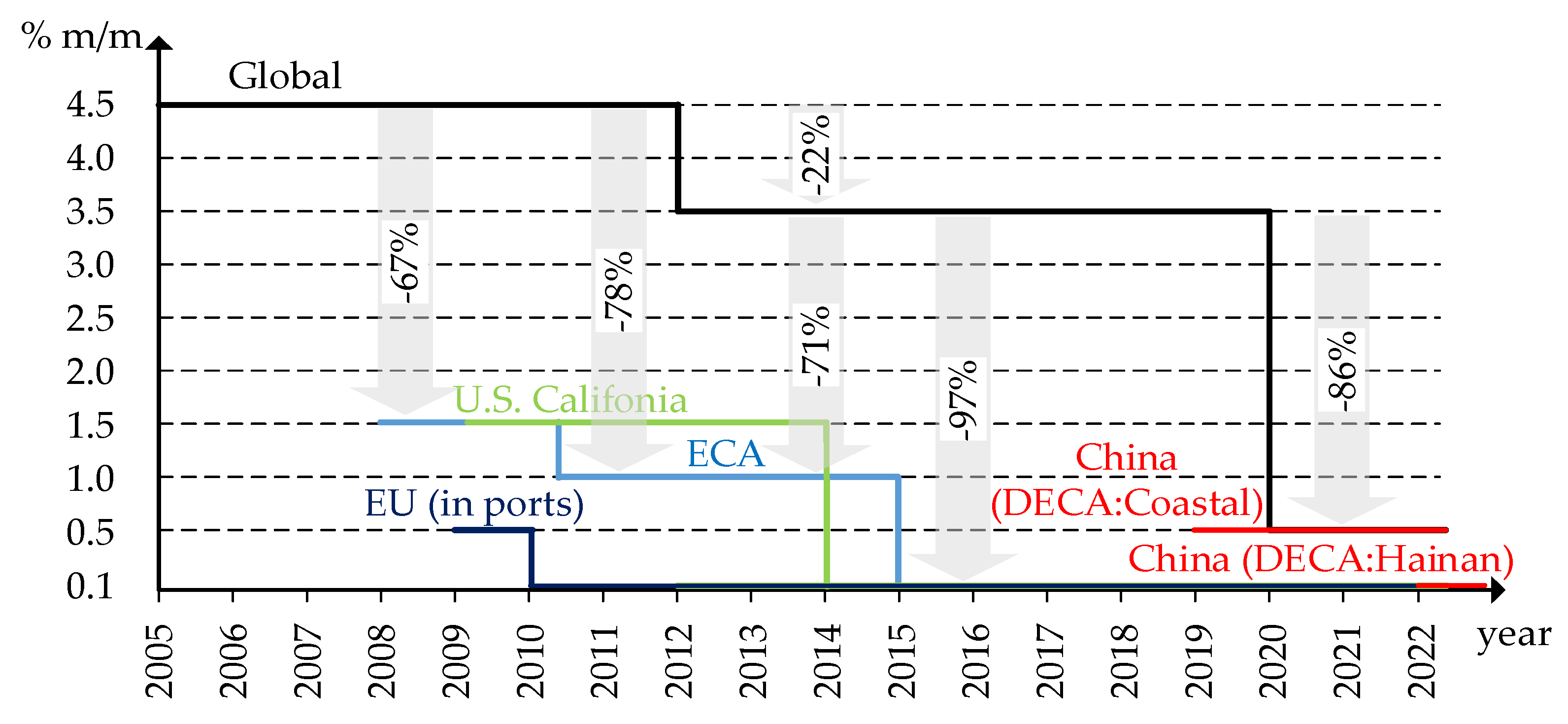
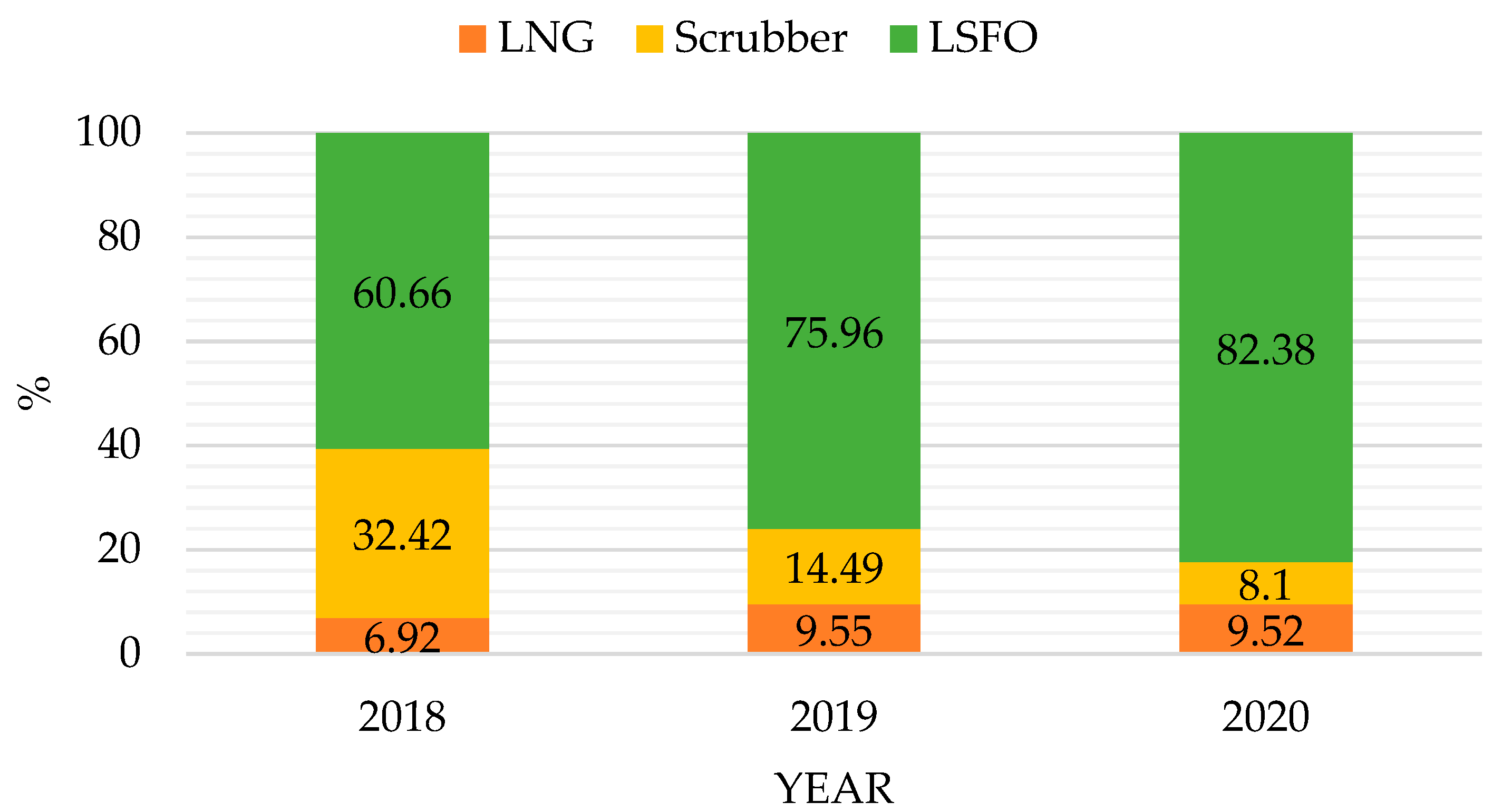
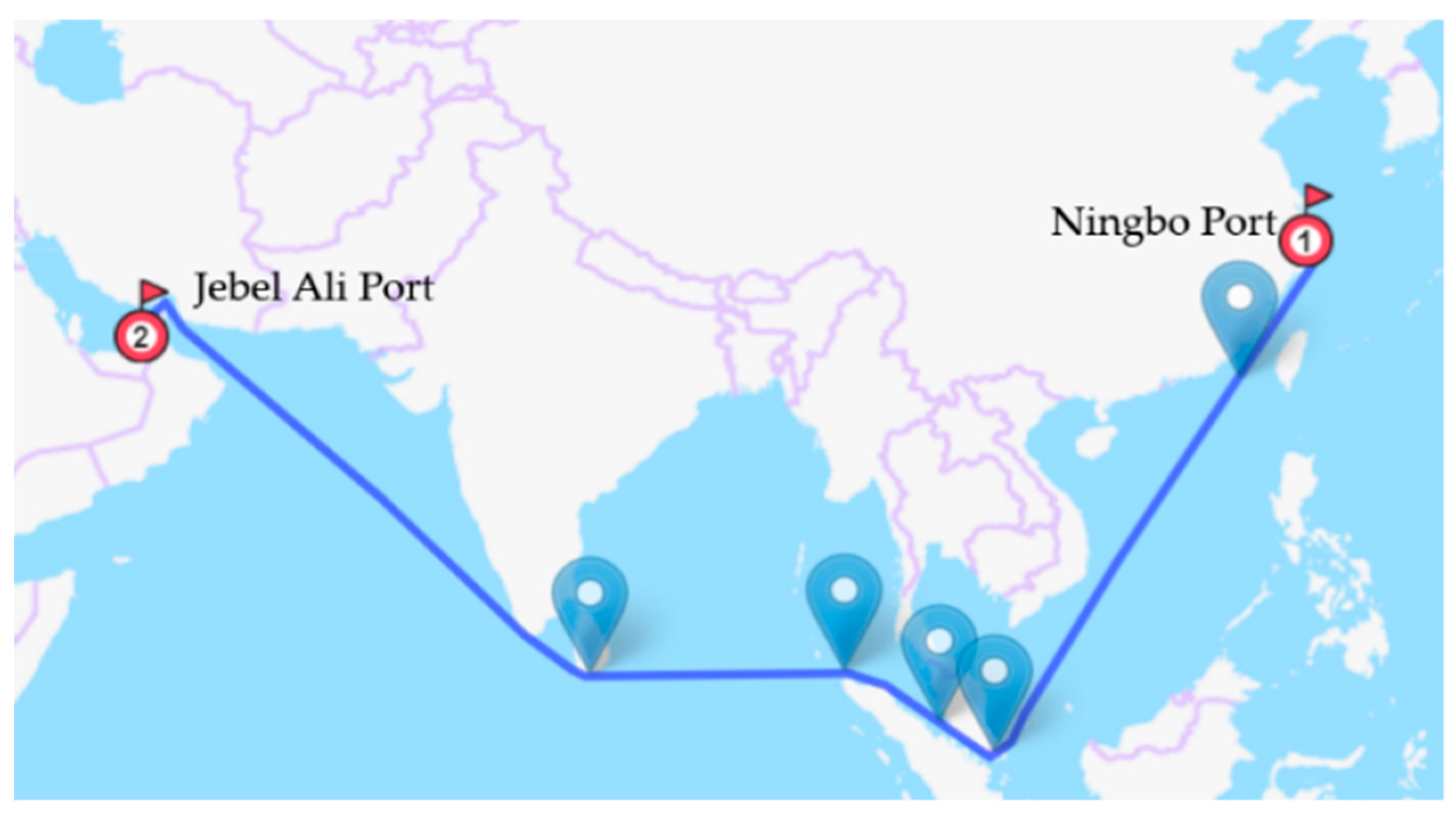
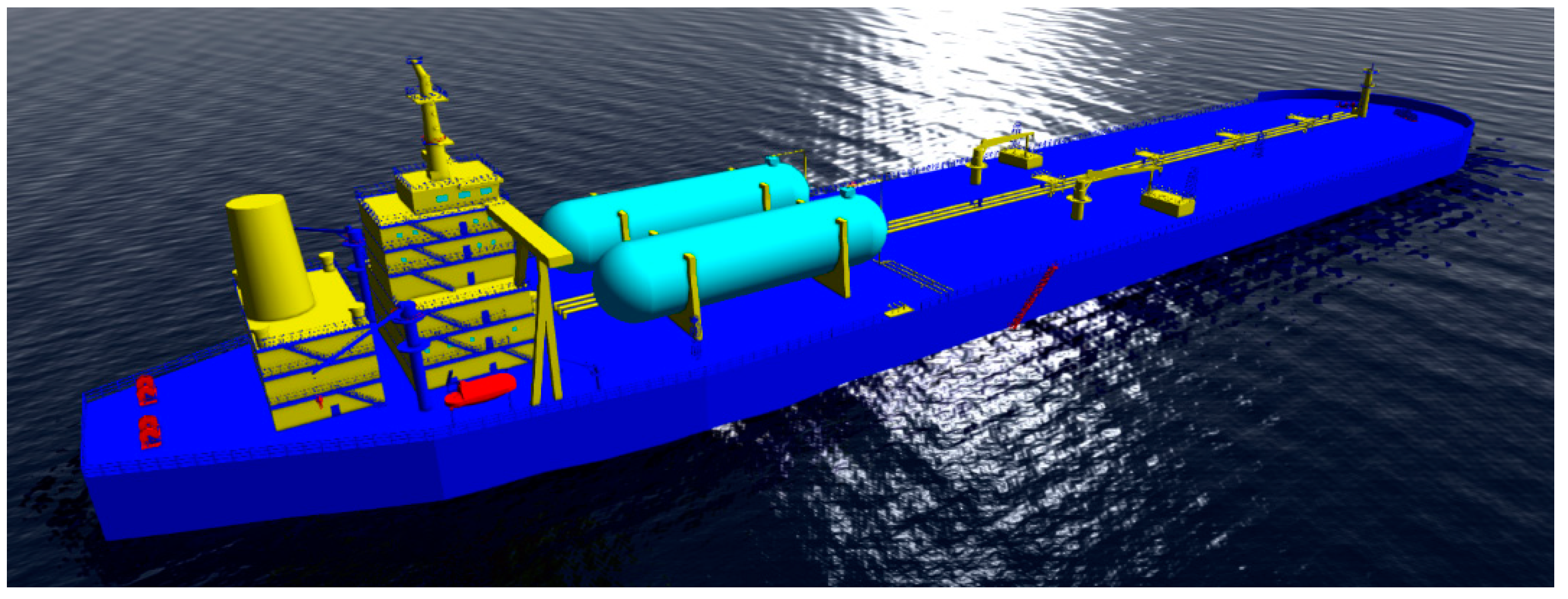
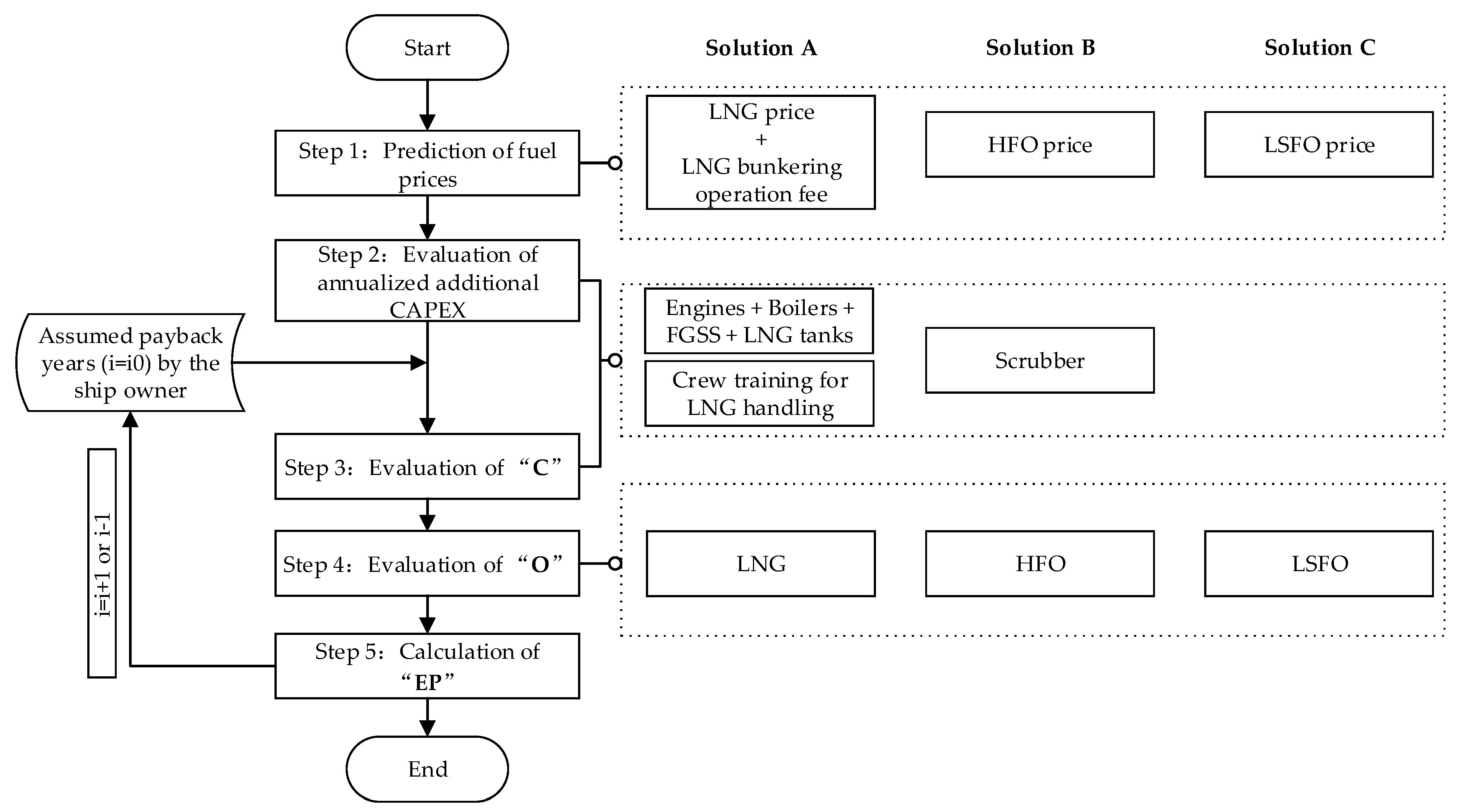
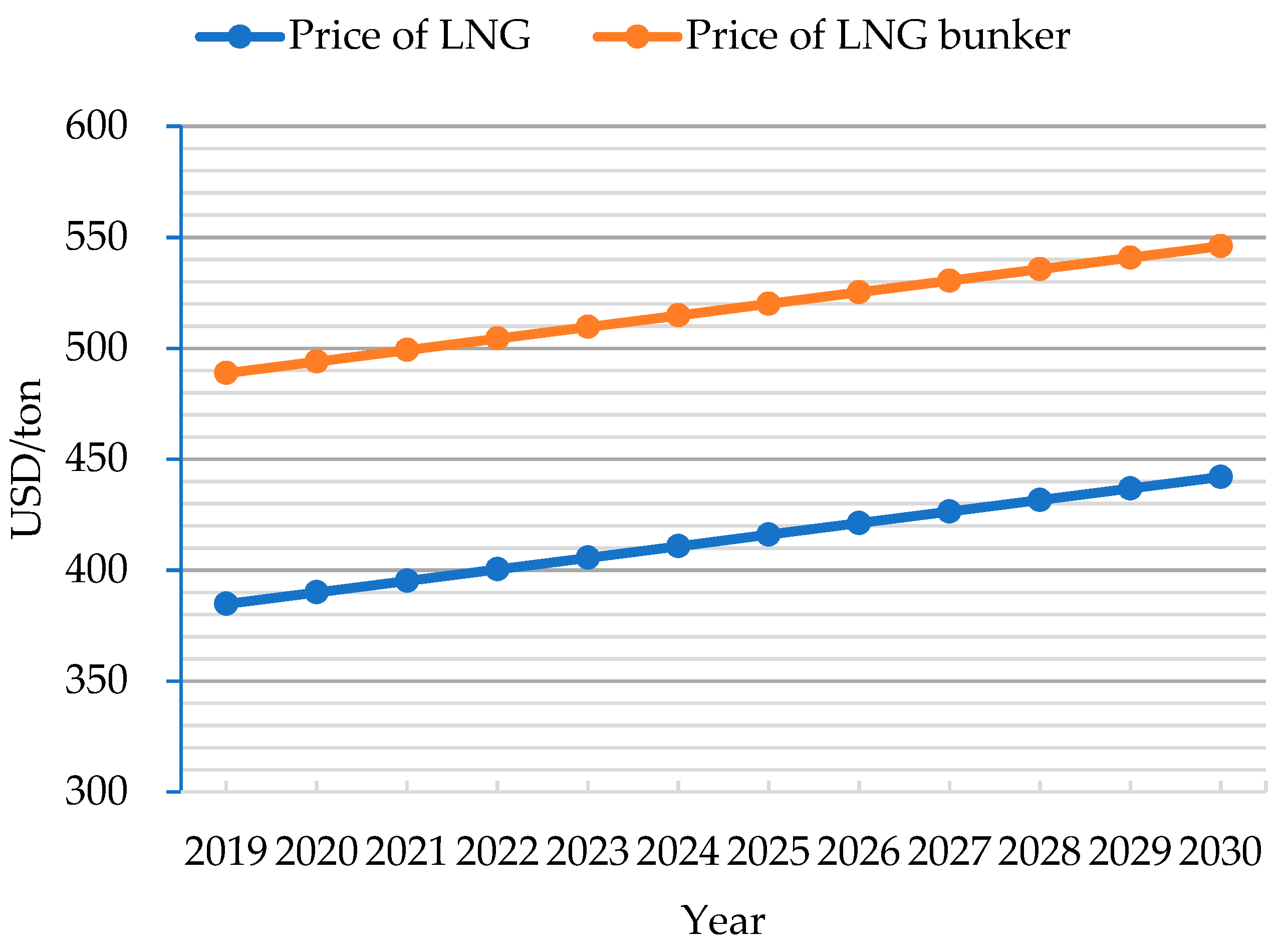
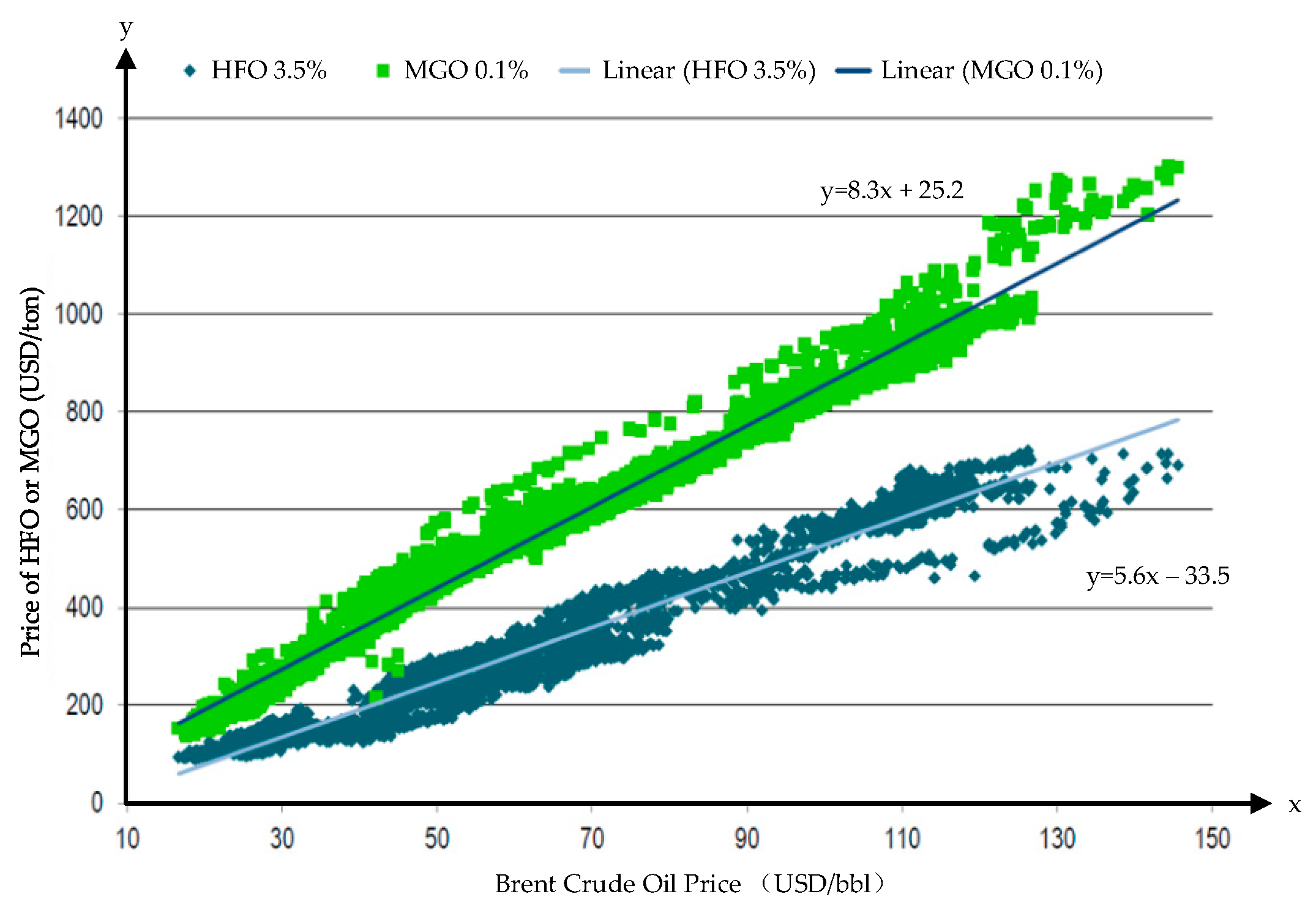

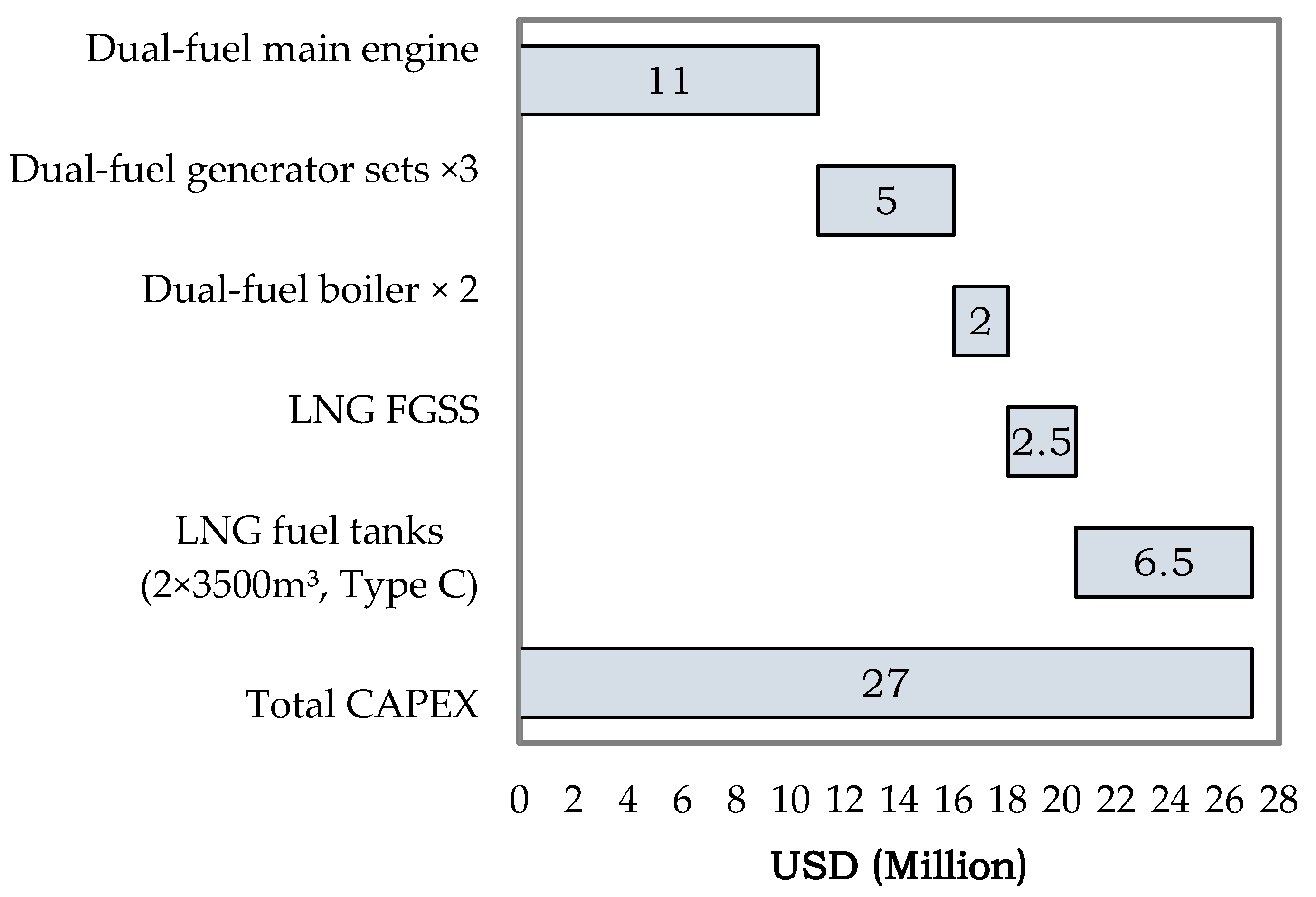
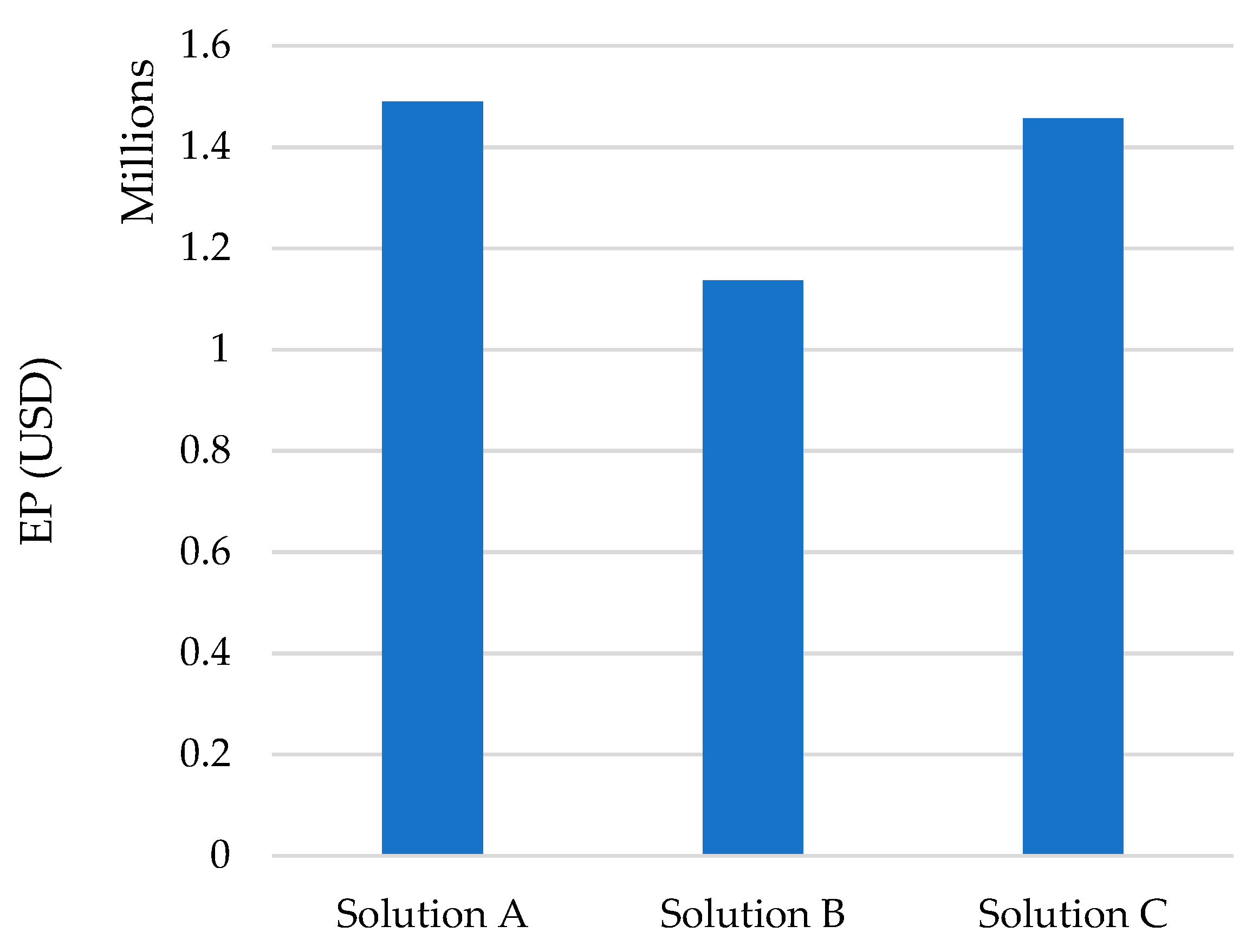
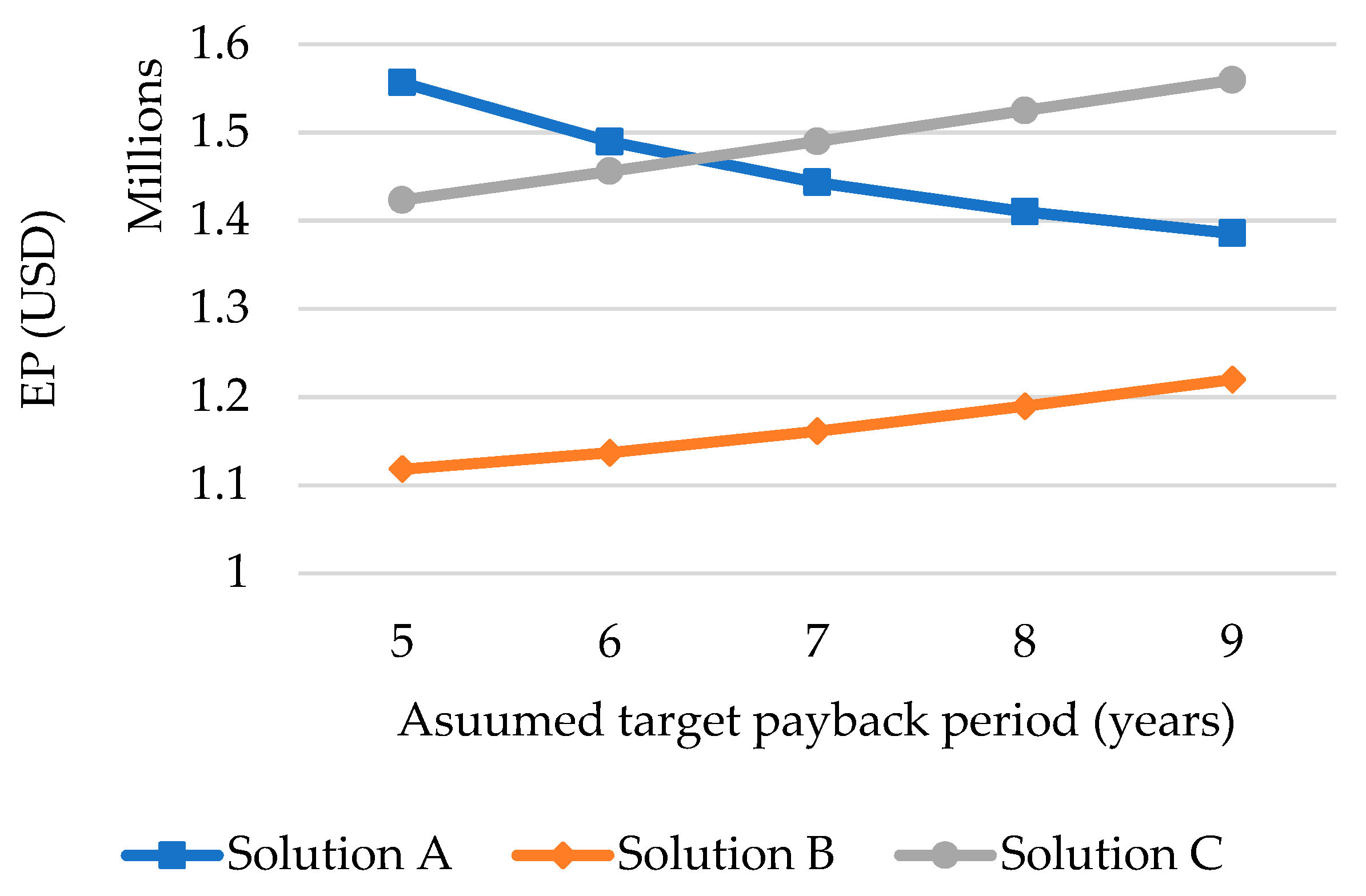
| Year | Numbers of Ships |
|---|---|
| 2018 | 1965 |
| 2019 | 1539 |
| 2020 | 704 |
| Parameter | Value | Unit | |
|---|---|---|---|
| Basic data | Maximum deadweight (DWT) | 318,000 | tons |
| Length between perpendiculars | 319.00 | m | |
| Breath mid. | 58.00 | m | |
| Depth | 30.00 | m | |
| Design draught | 19.83 | m | |
| Design speed | 15.50 | knots | |
| Economical speed | 12.5 | knots | |
| Round trip voyage | 43 | days | |
| Solution A | Rated power of dual fuel main engine | 25,000 | kW |
| Rated power of dual fuel generator sets | 3 × 1400 | kW | |
| Fuel consumption of dual fuel boilers | 140 | ton/voyage | |
| Supply pressure of the FGSS | 5~16 | bar | |
| Capacity of LNG tanks | 2 × 3500 | m3 | |
| Solution B and C | Main engine rated power | 25,360 | kW |
| Laden, Tons/Day | Ballast, Tons/Day | |||
|---|---|---|---|---|
| Speed (knots) | Main Engine 1 | Auxiliary Engines | Main Engine 1 | Auxiliary Engines |
| 10.0 | 34 | 5.8 | 28 | 5.8 |
| 10.5 | 38 | 5.8 | 31 | 5.8 |
| 11.0 | 41 | 5.8 | 37 | 5.8 |
| 11.5 | 46 | 5.8 | 42 | 5.8 |
| 12.0 | 50 | 4.5 | 44 | 4.5 |
| 12.5 | 57 | 4.5 | 50 | 4.5 |
| 13.0 | 60 | 4.5 | 53 | 4.5 |
| 13.5 | 65 | 4.5 | 58 | 4.5 |
| 14.0 | 71 | 4.5 | 62 | 4.5 |
| 14.5 | 78 | 4.5 | 66 | 4.5 |
| 15.0 | 83 | 4.5 | 75 | 4.5 |
| 15.5 | 88 | 4.5 | 81 | 4.5 |
| Parameter | Value | ||
|---|---|---|---|
| Solution A | Solution B | Solution C | |
| Economical speed (knots) | 12.5 | 12.5 | 12.5 |
| Fuel consumption per day, main engine (Laden, tons) | 48.8 | 57.0 | 54.0 |
| Fuel consumption per day, main engine (Ballast, tons) | 42.8 | 50.0 | 47.4 |
| Fuel consumption per day, auxiliary engine (tons) | 4.5 | 5.6 | 5.3 |
| Fuel consumption per voyage, boilers (tons) | 132.7 | 165.0 | 156.4 |
| Sailing per voyage (days) | 38.0 | 38.0 | 38.0 |
| In ports per voyage (days) | 5.0 | 5.0 | 5.0 |
| Voyages per year | 8.0 | 8.0 | 8.0 |
| Fuel consumption per voyage (tons) | 2042.9 | 2410.8 | 2285.4 |
| Average fuel price for 2022–2027 (USD) | 517.4 | 400.6 | 637.1 |
| Fuel cost per voyage (USD) | 1,056,985.8 | 965,766.5 | 1,456,020.6 |
| Operating cost per voyage for the scrubber (USD) | 0.0 | 69,385.0 1 | 0.0 |
| Additional initial investment on equipment (USD) | 17,000,000.0 | 4,000,000.0 | 0.0 |
| Additional cost of crew training (USD) | 18,400 | 0.0 | 0.0 |
| Total additional initial investment (USD) | 17,018,400.0 | 4,000,000.0 | 0.0 |
| Annualized additional CAPEX (USD) | 3,460,906.6 | 813,450.5 | 0.0 |
| C (USD) | 432,613.3 | 101,681.3 | 0.0 |
| O (USD) | 1,056,985.8 | 1,035,151.4 | 1,456,020.6 |
| EP (USD) | 1,489,599.1 | 1,136,832.8 | 1,456,020.6 |
| Phase | Period | Reduction Factor |
|---|---|---|
| 0 | 1 Jan. 2013–31 Dec. 2014 | 0% |
| 1 | 1 Jan. 2015–31 Dec. 2019 | 10% |
| 2 | 1 Jan. 2020–31 Dec. 2024 | 20% |
| 3 | 1 Jan. 2025 and onwards | 30% |
| Solution | Fuel Type | Relative | Reduction | |||
|---|---|---|---|---|---|---|
| A | LNG | 2.750 | 152.077 | 418.211 | 80.4% | 19.6% |
| B | HFO | 3.114 | 167.000 2 | 520.038 | 100% | / |
| C | LSFO | 3.195 3 | 167.046 | 533.712 | 102.6% | −2.6% |
Publisher’s Note: MDPI stays neutral with regard to jurisdictional claims in published maps and institutional affiliations. |
© 2021 by the authors. Licensee MDPI, Basel, Switzerland. This article is an open access article distributed under the terms and conditions of the Creative Commons Attribution (CC BY) license (http://creativecommons.org/licenses/by/4.0/).
Share and Cite
Fan, H.; Tu, H.; Enshaei, H.; Xu, X.; Wei, Y. Comparison of the Economic Performances of Three Sulphur Oxides Emissions Abatement Solutions for a Very Large Crude Carrier (VLCC). J. Mar. Sci. Eng. 2021, 9, 221. https://doi.org/10.3390/jmse9020221
Fan H, Tu H, Enshaei H, Xu X, Wei Y. Comparison of the Economic Performances of Three Sulphur Oxides Emissions Abatement Solutions for a Very Large Crude Carrier (VLCC). Journal of Marine Science and Engineering. 2021; 9(2):221. https://doi.org/10.3390/jmse9020221
Chicago/Turabian StyleFan, Hongjun, Huan Tu, Hossein Enshaei, Xiangyang Xu, and Ying Wei. 2021. "Comparison of the Economic Performances of Three Sulphur Oxides Emissions Abatement Solutions for a Very Large Crude Carrier (VLCC)" Journal of Marine Science and Engineering 9, no. 2: 221. https://doi.org/10.3390/jmse9020221
APA StyleFan, H., Tu, H., Enshaei, H., Xu, X., & Wei, Y. (2021). Comparison of the Economic Performances of Three Sulphur Oxides Emissions Abatement Solutions for a Very Large Crude Carrier (VLCC). Journal of Marine Science and Engineering, 9(2), 221. https://doi.org/10.3390/jmse9020221







